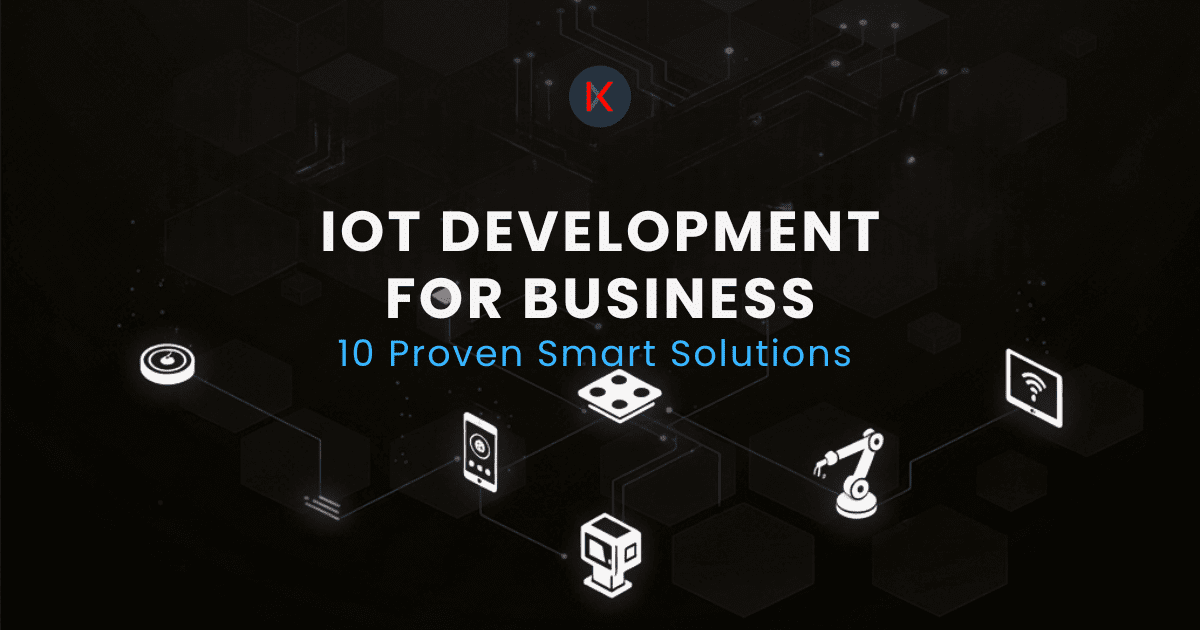Key Takeaways
- Predictive maintenance systems reduce equipment downtime by 50% and maintenance costs by 40%, preventing costly emergency repairs and production disruptions
- Smart inventory management with RFID sensors eliminates stockouts by 85% while reducing excess inventory carrying costs by $500,000+ annually for mid-size businesses
- Energy optimization IoT networks typically deliver 30% reduction in utility costs within 6 months through automated HVAC, lighting, and equipment controls
- Real-time asset tracking increases operational efficiency by 35% while reducing theft and loss by up to 90% across manufacturing and retail environments
- Environmental monitoring systems ensure compliance with regulations while optimizing conditions for productivity, reducing waste by 25% and improving worker safety
The Connected Business Revolution
Your competitors aren’t just adopting IoT development for business—they’re using it to fundamentally reimagine how work gets done. While you’re manually tracking inventory, they’re getting real-time alerts when stock runs low. While you’re scheduling maintenance based on guesswork, they’re predicting equipment failures weeks in advance.

The Internet of Things isn’t futuristic technology anymore. It’s the present reality of competitive business operations. Companies implementing IoT business solutions report average efficiency gains of 23%, cost reductions of 18%, and revenue increases of 15% within the first year of deployment.
But here’s what most business leaders get wrong: IoT development for business isn’t about the sensors—it’s about the decisions those sensors enable. The magic happens when raw data transforms into actionable intelligence that drives measurable business outcomes.
Why Traditional Business Operations Are Breaking Down
Walk into any manufacturing facility, retail store, or office building, and you’ll witness an epidemic of blind spots. Equipment runs until it breaks. Energy consumption happens without optimization. Inventory levels fluctuate based on historical patterns rather than real-time demand signals.
These operational blind spots cost American businesses over $50 billion annually in preventable downtime, wasted resources, and missed opportunities. According to McKinsey’s IoT research, companies that embrace IoT business solutions can capture $4-11 trillion in economic value by 2025.
The transformation isn’t optional anymore—it’s existential. Businesses that don’t implement smart sensors and connected systems will find themselves competing with severely outdated information while their competitors operate with real-time market intelligence.
The Hidden Costs of Manual Operations
Before diving into IoT implementation strategy, consider what your current approach is actually costing you:
Equipment Downtime: Reactive maintenance costs 3-5 times more than predictive maintenance. A single hour of unplanned downtime in manufacturing averages $50,000 in lost productivity, according to Aberdeen Group research. IoT development for business transforms this equation by predicting failures before they happen.
Inventory Inefficiencies: Manual inventory tracking leads to overstock situations that tie up working capital and stockouts that lose sales. Retail businesses lose an average of $1.1 trillion annually to inventory distortion—problems that smart sensors solve automatically.
Energy Waste: Buildings without IoT business solutions waste 20-30% of their energy consumption through inefficient HVAC operations, unnecessary lighting, and equipment running outside optimal parameters.
Labor Misallocation: Workers spend 30-40% of their time on data collection and monitoring tasks that sensors can handle automatically, preventing focus on high-value strategic activities.
10 Transformative Business IoT Applications
Manufacturing & Production Excellence
1. Predictive Maintenance Revolution
Smart sensors monitor vibration, temperature, and acoustic signatures to predict equipment failures weeks before they occur. IoT development for business in manufacturing typically reduces maintenance costs by 40% while eliminating 70% of unplanned downtime.
Industrial giants like General Electric save over $20 million annually through predictive maintenance on their jet engines. Their sensors collect 5,000 data points per second, enabling maintenance optimization that extends equipment life by 25%.
2. Quality Control Automation
Computer vision sensors integrated with IoT networks detect product defects in real-time, removing faulty items before they reach customers. This IoT implementation strategy reduces quality control labor costs by 60% while improving defect detection rates by 300%.
3. Supply Chain Visibility
GPS and cellular-enabled sensors track products from manufacture through delivery, providing complete visibility into supply chain performance. Businesses implementing this level of tracking report 45% improvement in on-time deliveries and 30% reduction in shipping costs.
Retail & Customer Experience
4. Smart Inventory Management
RFID tags and smart shelves automatically track inventory levels, triggering reorders when stock runs low and alerting staff to misplaced items. Retail chains implementing comprehensive RFID systems see 25% improvement in inventory accuracy and 15% reduction in out-of-stock situations.
5. Customer Behavior Analytics
Heat mapping sensors and proximity beacons track customer movement patterns, dwell times, and engagement with displays. This IoT business solutions approach increases conversion rates by 20% through optimized store layouts and personalized marketing triggers.
6. Dynamic Pricing Optimization
IoT sensors monitor competitor pricing, inventory levels, and customer demand patterns to automatically adjust prices for maximum profitability. Dynamic pricing systems typically increase profit margins by 10-25% while maintaining competitive positioning.
Facilities & Energy Management
7. Intelligent Building Systems
Smart HVAC, lighting, and security systems adapt to occupancy patterns, weather conditions, and energy costs. Commercial buildings with comprehensive IoT implementation strategy reduce energy consumption by 30% and maintenance costs by 35%.
8. Environmental Monitoring
Air quality, temperature, humidity, and noise sensors ensure optimal working conditions while maintaining regulatory compliance. These systems improve employee productivity by 12% while reducing HVAC costs by 25%.
Logistics & Transportation
9. Fleet Management Optimization
GPS tracking, fuel monitoring, and driver behavior sensors optimize routes, reduce fuel consumption, and improve safety. Fleet operators report average savings of $1,200 per vehicle annually through comprehensive IoT business solutions.
10. Asset Tracking & Security
Real-time location tracking prevents theft, reduces loss, and optimizes asset utilization. Construction companies using IoT asset tracking reduce equipment theft by 90% and improve utilization rates by 40%.
Strategic IoT Implementation Framework
Phase 1: Assessment and Planning (Weeks 1-4)
Successful IoT development for business begins with comprehensive operational assessment. Identify processes with the highest potential impact through data analysis, employee interviews, and competitive benchmarking.
ROI Calculation Methodology: Calculate potential savings from reduced downtime, energy efficiency, labor optimization, and improved customer satisfaction. Prioritize implementations with payback periods under 18 months.
Infrastructure Readiness: Assess network capacity, data storage capabilities, and integration requirements. Many businesses discover their existing IT infrastructure needs upgrades to support comprehensive IoT deployments.
Phase 2: Pilot Project Execution (Weeks 5-12)
Start with focused pilot projects that demonstrate clear value and build organizational confidence. Manufacturing companies often begin with predictive maintenance on critical equipment, while retail businesses typically start with inventory management systems.
Data Quality Management: Establish protocols for data collection, validation, and analysis. Poor data quality kills IoT projects faster than technical failures. Implement automated data cleaning and validation processes from day one.
Security Framework: IoT devices create new security vulnerabilities that require proactive management. Implement device authentication, network segmentation, and continuous monitoring to prevent cyber attacks.
Phase 3: Scaling and Integration (Months 4-8)
Expand successful pilots across additional locations and departments. Focus on integration between different IoT systems to create comprehensive operational visibility.
Change Management: Employee adoption determines IoT success more than technology selection. Provide training, demonstrate benefits, and address concerns proactively. Resistance to change kills more IoT projects than technical issues.
Common IoT Implementation Pitfalls
Technology-First Thinking: Choosing sensors and devices before defining business outcomes leads to expensive technology deployments that don’t deliver measurable value. Always start with business objectives, then select technology that achieves those goals.
Data Overwhelm: IoT systems generate massive amounts of data that can overwhelm analysis capabilities. Focus on actionable metrics that drive specific business decisions rather than collecting data for its own sake.
Security Afterthoughts: Treating cybersecurity as an add-on rather than a fundamental requirement creates vulnerabilities that compromise entire networks. Plan security architecture before deploying any IoT devices.
Vendor Lock-in: Proprietary IoT platforms can trap businesses with limited flexibility and high switching costs. Choose open-standard solutions that enable vendor flexibility and future technology integration.
Measuring IoT Success
Financial Metrics That Matter:
- Return on Investment (ROI) within 12-18 months
- Operational cost reduction of 15-25%
- Revenue increase of 10-15% through improved efficiency
- Payback period calculation including maintenance and upgrade costs
Operational Performance Indicators:
- Equipment uptime improvement of 20%+
- Energy consumption reduction of 25%+
- Inventory accuracy improvement of 30%+
- Customer satisfaction score increases of 15%+
The Future of Connected Business
IoT development for business is evolving rapidly with artificial intelligence integration, edge computing capabilities, and 5G connectivity. Companies implementing IoT business solutions today position themselves for competitive advantages that compound over time.
Edge computing brings data processing closer to sensors, reducing latency and enabling real-time decision making. AI integration transforms reactive monitoring into predictive optimization that anticipates needs before problems develop.
The businesses that master IoT implementation strategy today will dominate their markets tomorrow. Those that wait will find themselves competing with fundamentally disadvantaged operational capabilities.
At Kinetik Dynamic, we’ve guided dozens of businesses through successful IoT transformations across manufacturing, retail, healthcare, and logistics industries. Our approach combines strategic business planning with technical implementation expertise that delivers measurable results.
Ready to Transform Your Operations?
Don’t let competitors gain operational advantages while you’re still managing business through manual processes and guesswork. Every day without IoT business solutions means lost opportunities for cost savings, efficiency gains, and competitive positioning.

Discover your IoT transformation potential:
- Comprehensive operational assessment identifying highest-impact opportunities
- Custom IoT implementation roadmap with specific milestones and ROI projections
- Technology selection guidance ensuring optimal performance and future scalability
- Strategic planning sessions focused on sustainable competitive advantage creation
Schedule Your IoT Strategy Consultation and discover how IoT development for business can revolutionize your operations. Our team has implemented IoT solutions delivering millions in cost savings and efficiency gains—let us show you what’s possible for your business.
Strategic IoT consultations limited to 4 comprehensive sessions monthly. Reserve your transformation planning now.
FAQ
Q: How long does IoT development for business implementation typically take? A: Pilot projects can deploy in 6-12 weeks, with full-scale implementation taking 6-12 months depending on scope. Manufacturing predictive maintenance pilots often show ROI within 3 months, while comprehensive facility management systems require 8-12 months for full deployment and optimization.
Q: What’s the minimum budget needed for effective IoT business solutions? A: Meaningful IoT implementations start at $25,000-50,000 for focused applications like asset tracking or environmental monitoring. Comprehensive systems with predictive analytics range from $100,000-500,000 but typically deliver ROI within 18 months through operational savings.
Q: How do I ensure IoT implementation strategy delivers measurable results? A: Define specific, measurable objectives before deployment. Track baseline metrics for 30-60 days, then measure improvements monthly. Focus on outcomes like cost reduction, efficiency gains, and revenue impact rather than technology metrics like data volume or sensor count.
Q: What industries benefit most from smart sensors for business applications? A: Manufacturing sees the highest ROI through predictive maintenance and quality control. Retail benefits significantly from inventory management and customer analytics. Healthcare, logistics, agriculture, and energy sectors also achieve substantial operational improvements through targeted IoT deployments.
